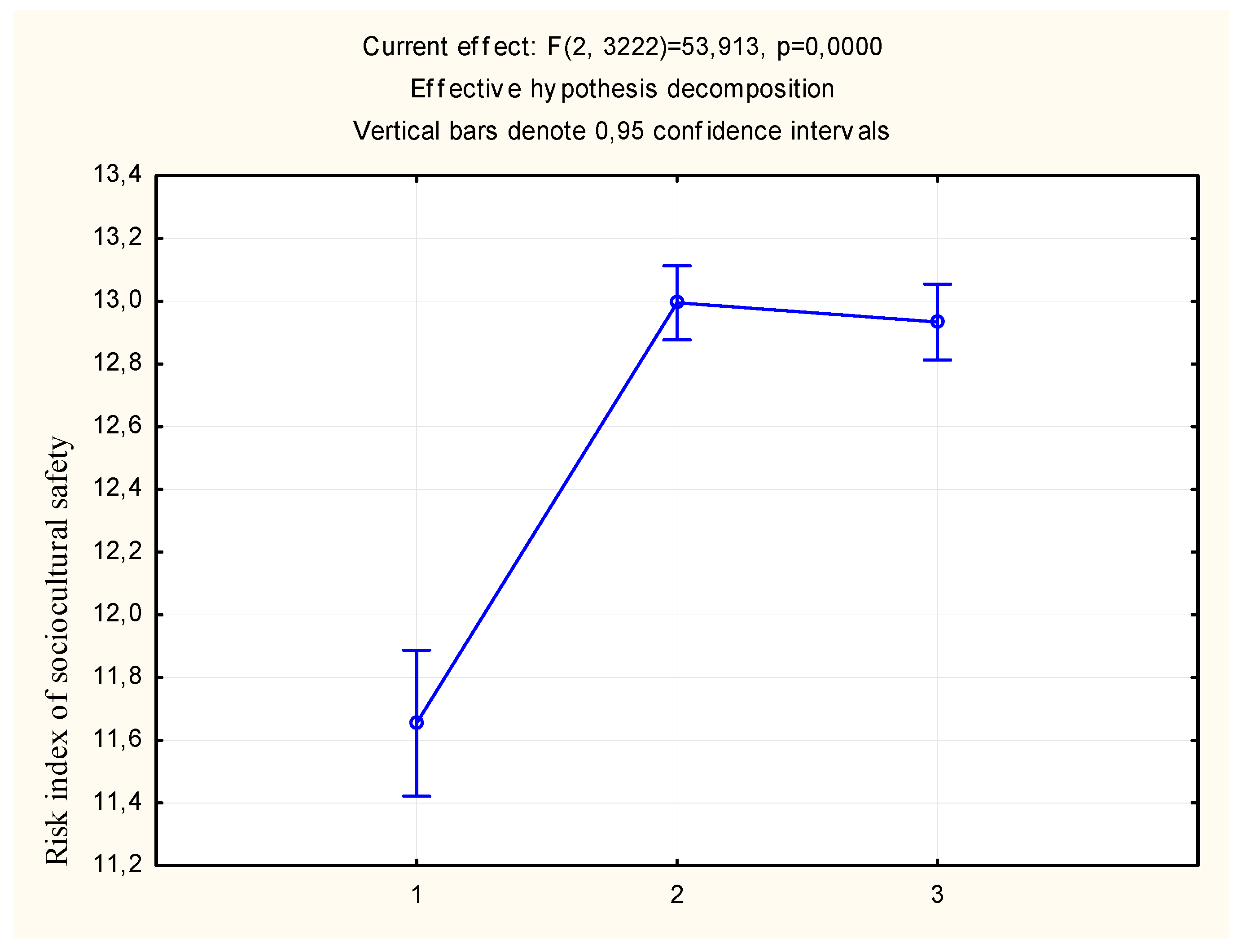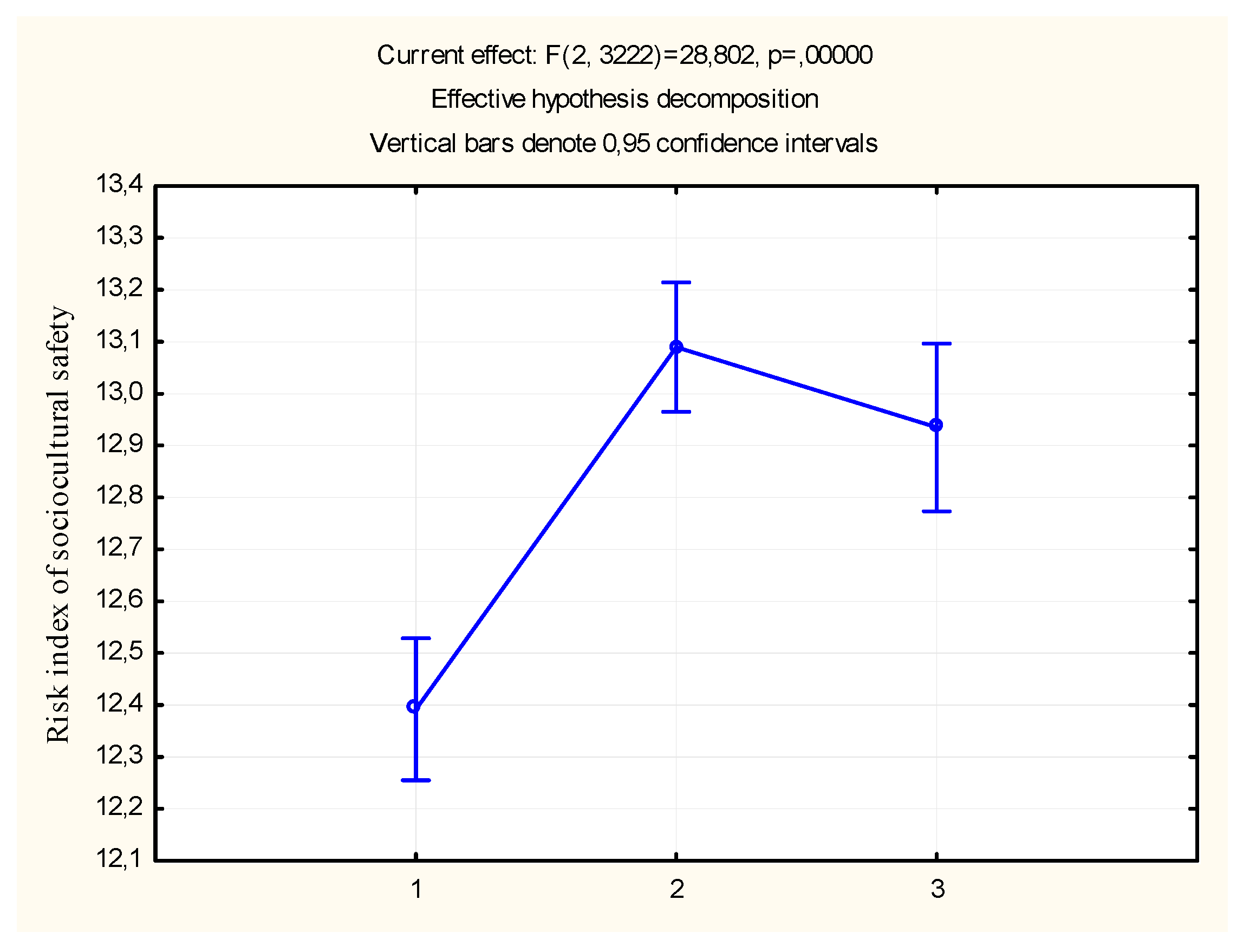Socio-Psychological Safety of Schools in the Context of the Settlement Type and Socio-Economic Status of the Region
Abstract
1. Introduction
1.1. Research Background
1.2. Research Methodology
1.3. Research Questions
2. Materials and Methods
2.1. Participants
2.2. Data Source
2.3. Procedure
3. Results
4. Discussion
5. Conclusions
- The economic, social, and geographical status of a region affects the social and psychological safety of a school, but this influence is non-linear and not strong.
- In schools located in areas with high and average earnings, the risk of violation of the socio-psychological safety of the educational environment is significantly higher than in schools where the level of wages is lower than the average with other conditions being equal.
- Schools located in areas with both high and low employment have an increased risk profile of the educational environment compared to areas with average employment rates.
- In cities and towns of urban type, the severity of the risk of socio-psychological safety of the educational environment of the school is significantly higher than in the village than the average with other conditions being equal.
6. Strengths and Limitations
Funding
Conflicts of Interest
References
- Gilemkhanova, E. Contextual Factors in Assessing the Sociocultural Risks of the Educational Environment of the XIX April International Scientific Conference on Economic and Social Development; High School of Economics: Moscow, Russia, 2018; Available online: https://conf.hse.ru/pubs/share/direct/220103399 (accessed on 21 June 2019).
- Mwoma, T.; Begi, N.; Murungi, C. Safety and safety in preschools: A challenge in informal settlements. Issues Educ. Res. 2018, 28, 720–736. Available online: http://www.iier.org.au/iier28/mwoma.pdf (accessed on 15 June 2019).
- Kisfalusi, D. Bullies and Victims in Primary Schools. Intersections. East Eur. J. Soc. Politics 2018, 4, 133–158. [Google Scholar]
- Hall, W.J.; Chapman, M.V. The role of school context in implementing a statewide anti-bullying policy and protecting pupils. Educ. Policy 2018, 32, 507–539. [Google Scholar] [CrossRef] [PubMed]
- Anderson, C.S. The Search for School Climate: A Review of the Research. Rev. Educ. Res. Fall 1982, 52, 368–420. [Google Scholar] [CrossRef]
- Argyris, C. Some problems in conceptualizing organizational climate: A case study of a bank. Adm. Sci. Q. 1958, 2, 501–520. [Google Scholar] [CrossRef]
- Brookover, W.B.; Beady, C.; Flood, P.; Schweitzer, J.; Wisenbaker, J. School Social Systems and Student Achievement; Praeger: New York, NY, USA, 1979; 237p, Available online: http://www.sciencedirect.com/science/article/pii/0272-7757(81)90009-1 (accessed on 26 July 2019).
- Coleman, J.S. Methods and results in the IE A studies of effects of schools on learning. Rev. Educ. Res. 1975, 45, 355–386. [Google Scholar] [CrossRef]
- Snow, R.E. Theory construction for research on teaching. In Second Handbook of Research on Teaching; Travers, R.M.W., Ed.; Rand McNally: Chicago, IL, USA, 1973; pp. 77–112. [Google Scholar]
- Levin, H.M. A New Model of School Effectiveness: A Report on Recent Research on Pupil Achievement; Stanford University, Stanford Center for Research and Development on Teaching: Stanford, CA, USA, 1970. [Google Scholar]
- Vygotsky, L. Mind in Society. The ппппDevelopment of Higher Psychological Processes; Harvard Univ. Press: Cambridge, MA, USA, 1978; 159p. [Google Scholar]
- Barker, R.G.; Wright, H.F. Ecological Psychology; Stanford University Press: Stanford, CA, USA, 1968. [Google Scholar]
- Levin, K. Field Theory in the Social Sciences; Transl. E. Surpina. Rech’ Publ.: St. Petersburg, Russia, 2000; 365p. [Google Scholar]
- Bronfenbrenner, U. Ecological systems theory. Ann. Child Dev. 1989, 6, 187–249. [Google Scholar]
- Hu, W.; Wang, R. Segregation in urban education: Evidence from public schools in shanghai, China. Cities 2019, 87, 106–113. [Google Scholar] [CrossRef]
- Olsson, G.; Fritzell, J. A multilevel study on ethnic and socioeconomic school stratification and health-related behaviors among students in Stockholm. J. Sch. Health 2015, 85, 871–879. [Google Scholar] [CrossRef] [PubMed]
- Chen, P.; Vazsonyi, A.T. Future orientation, school contexts, and problem behaviors: A multilevel study. J. Youth Adolesc. 2013, 42, 67–81. [Google Scholar] [CrossRef] [PubMed]
- Alm, S.; Låftman, S.B. Future orientation climate in the school class: Relations to adolescent delinquency, heavy alcohol use, and internalizing problems. Child. Youth Serv. Rev. 2016, 70, 324–331. [Google Scholar] [CrossRef]
- Gibson, J.J. The Ecological Approach to Visual Perception: Classic Edition; Psychology Press: New York, NY, USA, 2015; p. 316. [Google Scholar]
- Edmonds, R.R. Effective Schools for the Urban Poor. Educational Leadership, 1979. Available online: http://www.ascd.org/ASCD/pdf/journals/ed_lead/el_197910_edmonds.pdf (accessed on 15 June 2019).
- McDill, E.L.; Meyers, E.D.; Rigsby, L.C. Institutional effects on the academic behavior of high school pupils. Sociol. Educ. 1967, 40, 181–199. [Google Scholar] [CrossRef]
- Gilemkhanova, E. Technique “Adolescence Socio-Cultural Safety Index”. Vestnik Moskovskogo Universiteta: Seriya 14. Psikhologiya 2019, 2, 164–183. [Google Scholar] [CrossRef]
- Aslund, C.; Leppert, J.; Starrin, B.; Nilsson, K. Subjective social status and shaming experiences in relation to adolescent depression. Arch. Pediatr. Adolesc. Med. 2009, 163, 55–60. [Google Scholar] [CrossRef] [PubMed]
- Reiss, F.; Meyrose, A.; Otto, C.; Lampert, T.; Klasen, F.; Ravens-Sieberer, U. Socioeconomic status, stressful life situations and mental health problems in children and adolescents: Results of the German BELLA cohort-study. PLoS ONE 2019, 14. [Google Scholar] [CrossRef] [PubMed]
- Votruba-Drzal, E. Economic disparities in middle childhood development: Does income matter? Dev. Psychol. 2006, 42, 1154–1167. [Google Scholar] [CrossRef]
- Perez, L.G.; Oh, A.; Dwyer, L.A.; Perna, F.M.; Berrigan, D. School contextual correlates of physical activity among a national adolescent sample. Prev. Med. Rep. 2019, 14. [Google Scholar] [CrossRef]
- Piotrowska, P.J.; Stride, C.B.; Maughan, B. Richard Rowe Mechanisms underlying social gradients in child and adolescent antisocial behavior SSM. Popul. Health 2019, 7. [Google Scholar] [CrossRef]
- Duke, D.L.; Perry, C. Can alternative schools succeed where Benjamin Spock, Spiro Agnew and B. F. Skinner have failed? Adolescence 1978, 13, 375–392. [Google Scholar] [PubMed]
- Morocco, J.C. The relationship between the size of elementary schools and pupils perceptions of their environment. Education 1978, 98, 451–454. [Google Scholar]



| Gender | Frequency | Percentage | Valid Percentage | |
|---|---|---|---|---|
| Valid | Male | 1456 | 45 | 45 |
| Female | 1618 | 50 | 50 | |
| Not specify | 158 | 5 | 5 | |
| Total | 3232 | 100 | 100 | |
| Outcome variable Index of safety | Technique “Adolescence socio-cultural safety index”. 3375 pupils from 13 to 16 years (53% of girls, 47% of boys) participated in a research. Psychometric characteristics of a technique are provided: Reliability (α Cr = 0.76), validity (r = 0.71), discriminatory power (δ = 0.9). Technique “Adolescence socio-cultural safety index” has general scale “Index of sociocultural safety” and three additional scales: Socio-psychological vulnerability; socio-psychological disintegration; virtual authorization. Socio-psychological vulnerability—characteristic of the subject of school interactions, causing high susceptibility to risks of the educational environment. It is connected with passivity, pliability to external influence, hypersensitivity to nuances of social interaction. Problems of social and psychological interaction of the pupil and other subjects of an educational system are expressed in the self-destroying trends, the direction of destructive impulses on themselves, and is followed by sense of guilt, the sensitivity increased by uneasiness. Examples of questions: For some reason as a rule all cones pour on me. If other people cause in me delight and a charm, I am disappointed in myself more and more. Socio-psychological disintegration—characteristic of the subject of school interactions, who’s problems connected with a mismatch of individual mental introject and dispositions with background characteristics of the educational environment and subjects of educational process. Key risk—isolation, the estrangement defining also inertness and not inclusiveness in an educational system. Examples of questions: I am not satisfied with those relations which at me developed with schoolmates. I would like to pass into other class. Virtual authorization characteristic of the subject of school interactions, causing social and psychological disadaptation as a result of the broken social interaction which is expressed in preference of the depersonalized communication, problems of self-identification, marginal identity and an unproductive reflection. Examples of questions: Communication is more free and entertaining on social networks. The avatar or the status incognito on social networks allows me more stoutly to prove myself, without being distracted by insignificant details. |
| Contextual variables | |
| Wages | Average amount of salary in rubles High level—16 schools Average level—16 schools Low level—4 schools |
| Employment | Percentage of employed people in the region High level—8 schools Average level—12 schools Low level—12 schools |
| Type of the settlement | Three types were identified: City, urban-type settlements, and village. In the study, the status of the city had eight settlements, 16 urban-type settlements, 12 villages. |
| Effect | Sigma-Restricted Parameterization Effective Hypothesis Decomposition | ||||
|---|---|---|---|---|---|
| SS | Degree of Freedom | MS | F | p | |
| Intercept | 346,397.4 | 1 | 346,397.4 | 65,504.63 | 0.000 |
| Wages (3-high level; 2-average level; 1-low level) | 570.2 | 2 | 285.1 | 53.91 | 0.000 |
| Error | 17,038.4 | 3222 | 5.3 | ||
| Effect | Sigma-Restricted Parameterization Effective Hypothesis Decomposition | ||||
|---|---|---|---|---|---|
| SS | Degree of Freedom | MS | F | p | |
| Intercept | 464,469.6 | 1 | 464,469.6 | 85,826.37 | 0.000 |
| The share of the employed population in the region (3-high level; 2-average level; 1-low level) | 172.0 | 2 | 86.0 | 15.89 | 0.000 |
| Error | 17,436.6 | 3222 | 5.4 | ||
| Effect | Sigma-Restricted Parameterization Effective Hypothesis Decomposition | ||||
|---|---|---|---|---|---|
| SS | Degree of Freedom | MS | F | P | |
| Intercept | 265,816.5 | 1 | 265,816.5 | 50,293.87 | 0.000 |
| Wages (3-high level; 2-average level; 1-low level) | 418.1 | 2 | 209.0 | 39.55 | 0.000 |
| The share of the employed population in the region (3-high level; 2-average level; 1-low level) | 19.8 | 2 | 9.9 | 1.87 | 0.153541 |
| Error | 17,018.6 | 3220 | 5.3 | ||
| Effect | Sigma-Restricted Parameterization Effective Hypothesis Decomposition | ||||
|---|---|---|---|---|---|
| SS | Degree of Freedom | MS | F | p | |
| Intercept | 504,903.4 | 1 | 504,903.4 | 94,038.47 | 0.000 |
| City-3; urban-type settlement-2; village-1 | 309.3 | 2 | 154.6 | 28.80 | 0.000 |
| Error | 17,299.3 | 3222 | 5.4 | ||
| Standardized Coefficients | F | p | ||
|---|---|---|---|---|
| Beta | Standard Error | |||
| The share of the employed population in the region | −0.024 | 0.049 | 0.230 | 0.631 |
| type of the settlement | 0.055 | 0.031 | 3.143 | 0.076 |
| Wages | 0.146 | 0.026 | 32.169 | 0.000 |
© 2019 by the author. Licensee MDPI, Basel, Switzerland. This article is an open access article distributed under the terms and conditions of the Creative Commons Attribution (CC BY) license (http://creativecommons.org/licenses/by/4.0/).
Share and Cite
Gilemkhanova, E.N. Socio-Psychological Safety of Schools in the Context of the Settlement Type and Socio-Economic Status of the Region. Behav. Sci. 2019, 9, 139. https://doi.org/10.3390/bs9120139
Gilemkhanova EN. Socio-Psychological Safety of Schools in the Context of the Settlement Type and Socio-Economic Status of the Region. Behavioral Sciences. 2019; 9(12):139. https://doi.org/10.3390/bs9120139
Chicago/Turabian StyleGilemkhanova, Elvira N. 2019. "Socio-Psychological Safety of Schools in the Context of the Settlement Type and Socio-Economic Status of the Region" Behavioral Sciences 9, no. 12: 139. https://doi.org/10.3390/bs9120139
APA StyleGilemkhanova, E. N. (2019). Socio-Psychological Safety of Schools in the Context of the Settlement Type and Socio-Economic Status of the Region. Behavioral Sciences, 9(12), 139. https://doi.org/10.3390/bs9120139





